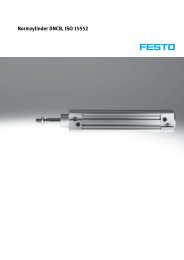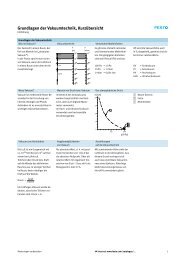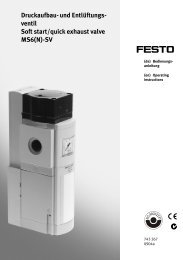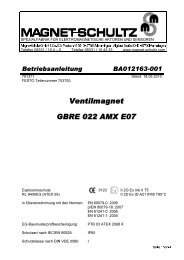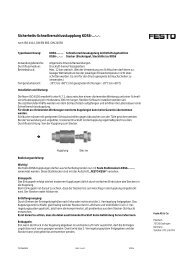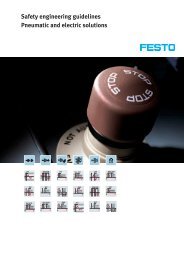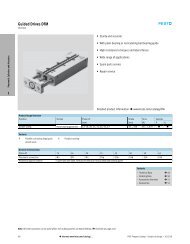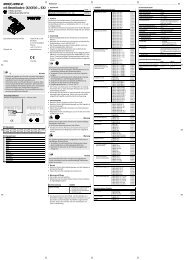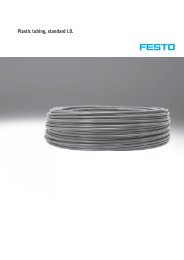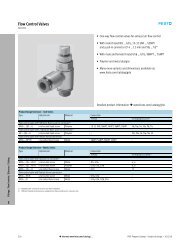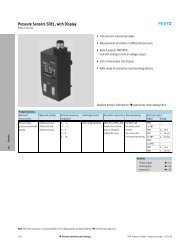Download latest edition - Festo
Download latest edition - Festo
Download latest edition - Festo
Create successful ePaper yourself
Turn your PDF publications into a flip-book with our unique Google optimized e-Paper software.
Automation optimises e-mobility<br />
Batteries move up a gear<br />
There are currently 2,300 electric cars on Germany’s roads. This fi gure is set to reach<br />
one million by 2020. The industry is currently dealing with the crucial question of how<br />
to make the leap to low-cost, high-volume battery production. The automation industry<br />
has some answers.<br />
In order to make electromobility more<br />
accessible for the broader market,<br />
the cost of batteries used in electric<br />
vehicles needs to come down. They<br />
are still one of the biggest cost drivers<br />
in electromobility. The problem is that<br />
battery production is still predominantly<br />
a manual process with a large number of<br />
individual steps.<br />
Competence cuts costs<br />
“Between 30 and 40 per cent of the value<br />
added in purely electric vehicles is due to<br />
the battery,” says Michael Karcher, Head<br />
of the industry segment Electronics and<br />
Solar at <strong>Festo</strong>. “If we are to eventually<br />
have effi cient mass production, we<br />
need to set up technologically fl exible<br />
electrode and cell production for the<br />
manufacture of battery prototypes with<br />
a high degree of standardisation and<br />
automation. This will allow production<br />
costs to be reduced and ensure the quality<br />
of the results.” This demands effective<br />
and reliable automation competence at<br />
all levels. Mechatronic solutions, which<br />
integrate expertise from different areas<br />
of process and factory automation and<br />
transfer it to the <strong>latest</strong> technologies in<br />
battery production, look promising.<br />
Innovation with mechatronics<br />
“Our customers from the automation industry<br />
have a good understanding of the<br />
automotive sector when it comes to their<br />
current fi eld of activities. However, when<br />
it comes to the optimum conditions for<br />
battery production engineering, they<br />
are more or less starting from scratch,”<br />
says Karcher. In order to fundamentally<br />
Ph Phot hott o o: D<br />
D aiml iiml er A AAG<br />
redefi ne processes you need innovators<br />
like mechatronics engineers and a<br />
willingness on the part of companies to<br />
innovate. This is exactly what happened<br />
in the case of automation system supplier<br />
and plant manufacturer ads-tec. The<br />
company, which is based near Stuttgart,<br />
develops automated production systems<br />
for high-performance lithium-ion energy<br />
storage devices.<br />
Protection of sensitive cells<br />
For the FUEL project initiated by the<br />
Federal Ministry of Education and Research<br />
(BMBF), ads-tec fi rst developed<br />
a production method for automating the<br />
bonding, feeding and handling of cells<br />
on a laboratory scale. According to Head<br />
of Automation Dr. Peter Korff, the aim<br />
was to provide production facilities that<br />
would allow the fast, low-cost production<br />
of cells and battery systems. “Lithiumion<br />
cells are sensitive. We must make<br />
sure that we maintain cell quality during<br />
the process and take care not to damage<br />
or contaminate them, particularly<br />
during handling. Because we have to<br />
create a whole new set of conditions for<br />
the accumulator production technology,<br />
we are open to new solutions and ideas.<br />
For handling the lithium-ion cells, we<br />
worked with <strong>Festo</strong> to devise a new frontend<br />
solution with an air bearing, which<br />
was previously only used for the solar or<br />
electrical industry,” explains Dr. Korff.<br />
Objects slide evenly<br />
Both the solar and electrical industries<br />
use the air bearing ATBT from <strong>Festo</strong> for<br />
the contactless transport of sheets of<br />
glass and delicate fi lm. A layer of air on<br />
the fi ne surface allows objects to glide<br />
evenly. For ads-tec, the engineers from<br />
<strong>Festo</strong> used the so-called reversal effect,<br />
with an extensive vacuum for the handling<br />
of battery packs in the production<br />
system. “With conventional solutions we<br />
could only grip the cells in certain places<br />
using vacuum generators, which meant<br />
that reliable holding of the cell could not<br />
be guaranteed,” says Michael Karcher.<br />
Because the air bearing grips the entire<br />
surface, the bonding process is no longer<br />
prone to failure caused by production.




